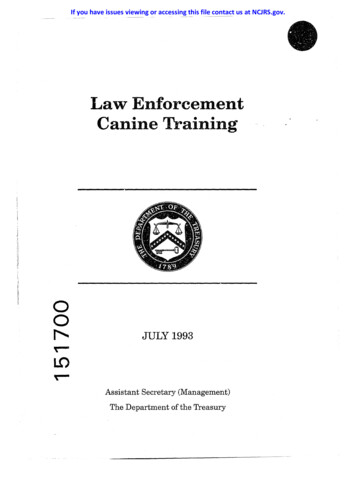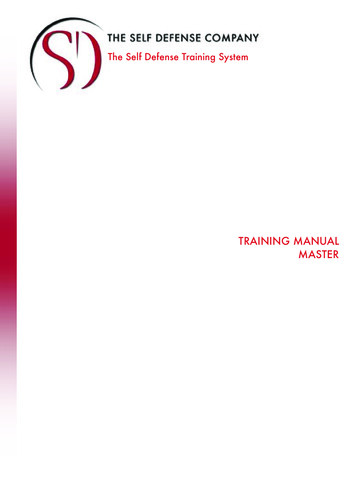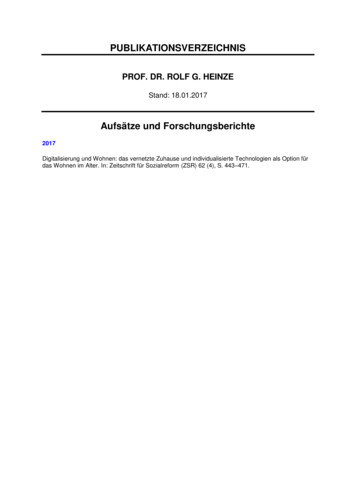
Transcription
The welfare impact and efficacy ofcanine training methods
DOGS TRUSTTHE WELFARE IMPACT AND EFFICACY OF CANINE TRAINING METHODSSummary of findings1What is an electric collar?The UK pet dog population of 2017 was estimated at 8.5 million1and in 2011 was estimated to be between 4.7 to 16.4 million2. Sincemany dogs are trained to some degree by their owners, the type oftraining and its impact on welfare on such large numbers of dogs is ahighly relevant issue. Electric shock collars, or ‘e-collars’, are training devices that deliver a static pulse(electric shock) to the dog via metal protrusions from the collar making contactwith the neck. They are used to reduce the display of unwanted behaviours, such aslivestock chasing, poor recall or crossing property boundaries. Collars can be activated by the owner by remote control, or automatically throughvibrations caused by barking or via transmitter on approach to a buried “invisible”fence. Other types of electric collar can emit squirts of citronella liquid or air puffs whenautomatically activated. These collars work on the principle of positive punishment (applying somethingunpleasant to the dog to reduce an unwanted behaviour) or in some cases negativereinforcement (removing something unpleasant to increase a desired behaviour). Vibration collars are remotely controlled collars which vibrate when activated, theseare marketed as a distraction technique, or to replace a verbal cue when training abehaviour such as recall.Why we advise against their use Research has shown that shocks from e-collars during training cause distress-relatedbehavioural reactions and are physically stressful for dogs. Training recall using reward based methods is more successful than using an e-collar. Bark activated shock and spray collars are ineffective in some dogs; a transitoryreduction in barking may occur when the collar is initially worn but this effect does notremain. Research demonstrates consistent links between positive punishment or negativereinforcement methods and problematic behaviours such as aggression, excitability andpoor learning ability. E-collars do not deal with the root cause of barking or other undesirable behaviours. Reward based methods are reported to be more effective and welfare compatible andtherefore should be preferentially used.Political context2 The use of electric shock collars has been banned in Wales since 2010. This ban hassince been upheld following judicial review. Scotland will soon be banning the use of static pulse, sonic and spray collars. There willbe a tightly controlled exemption for the use of vibration collars in training deaf dogs,which Dogs Trust supports. Only Westminster is able to ban the sale of these devices across the UK. We urge the Government to implement a ban on the use and sale of static pulse, sonicand spray collars, including boundary fence systems for dogs.IntroductionThe Animal Welfare Act (UK, 2006) states that an animal in the careof humans needs to be protected from pain, suffering, injury anddisease. The dog welfare code of practice advocates only positivereward based training, and avoiding harsh, painful or frightening(aversive) training methods. Scientific assessment of dog trainingmethods identifies any which may cause suffering, or poor welfare.Ethical debate over aversive training techniques has resulted in bansof electric shock collars in eight European countries and several statesin Australia. Many qualified animal behaviourists advocate avoidingaversive methods3,4 to promote good dog welfare, to reduce thelikelihood of dog relinquishment5 and strengthen the dog-ownerbond6. This report, summarises the available scientific evidence on theeffectiveness of different training methods and their impact on dogwelfare. Recommendations for training methods supporting optimumdog welfare have been made to help inform legislation in Englandand Scotland.1.1 Summary of trainingmethods and training devices1.2 Measuring dog welfare andassessing efficacy of trainingTraining methods are used by dog trainers and owners toincrease desirable behaviours and reduce undesirable behaviours.Reinforcement methods increase desirable behaviours whereaspunishment methods are used to reduce unwanted behaviour.Common reinforcers used in dog training include food, toys or play.Punishers include ‘time out’, verbal reprimands, physical correctionssuch as hitting, shaking, or smacking7 and applying aversive devicessuch as prong collars, bark activated collars (citronella and electricshock) and manual electric shock collars.‘Welfare measures’, for example, heart rate, and stress hormonereadings gained from dog urine and saliva samples, are used toanalyse the stress response system 8,9. These measures may be used toassess the impact of training methods on dog welfare. Dog behaviourresponses are also important indicators of stress. Negative (poorwelfare) behaviour responses include; yelping, trembling, whining,barking, panting, urinating or defecating 10, low ‘crouched’ posture11,and more subtle signs such as; ears held back, moving away andlip licking 11–13. Research studies assessing the impact of trainingmethods or devices on dogs collect a combination of the physical andbehavioural welfare measures.Electric shock collars, or ‘e-collars’, are devices used to remotelydeliver a static shock to the wearer via metal contacts with the neck.They are used to suppress behaviour such as livestock chasing or poorrecall. Electric and spray ‘bark collars’ are activated by vibrationscaused by barking, which release either an electric shock via metalcontacts on the collar, or a squirt of citronella liquid (or scentless /lemon liquid) towards the mouth and nose of the dog to suppressbarking. Prong collars or choke chains apply pressure to the neckvia tightening of a chain or metal prongs. The principle of both prongcollars and choke chains are to apply discomfort or pain when thedog is showing undesirable behaviour, and to release discomfortwhen the dog performs desirable behaviour.The efficacy of training methods describes how well they workto reduce or eliminate unwanted behaviour, or increase desirablebehaviours. This is assessed either by owner or researcher report ofchange, or by testing the dog in the situation where the behaviourwould usually be displayed to rate change. Studies reporting efficacyof training methods, and the welfare implications of each method,are summarised below.3
DOGS TRUST2THE WELFARE IMPACT AND EFFICACY OF CANINE TRAINING METHODSThe impact of manual electric shock collars on dog welfare3The impact of bark activated shock or spray collars on dog welfareFour studies reported significant behavioural reactionsto the e-collar shock which indicate anxiety or fear 8,14–16.Evidence linking changes in stress hormones (cortisol) withe-collar shocks were inconsistent. This may be becausestress hormones are released in both positive and negativesituations. In the studies where stress hormones weremeasured, all found an increase after the e-collar hadbeen used8,14,15,17, and one study17 found very high levels ofstress hormones as a result of the shock being given in anunpredictable way. Behavioural and physiological responsesto static shock undoubtedly show a negative impact on dogwelfare.Three studies explored the effect of bark activated sprayor shock collars on dog welfare. Two suggested that barkactivated collars have a negative impact on dog welfare andthe third study suggested that anxiety levels were unchangedby the collar.The most recent study14 showed that nine dogs being trained withan e-collar displayed behaviours including yelping and runningback to the owner, they also showed elevated stress hormone levelsafter being trained with the e-collar. The study then compared 63dogs completing recall training with a dog trainer either with ane-collar, without an e-collar, or using only reward based methods.Whilst dogs in the group using the e-collar showed signs ofanxiety or fear (tense behaviour, increased panting, yelping) stresshormone levels did not differ between dogs trained with differentmethods. An associated report to DEFRA18 on e-collars found thatowners were unclear about how to use the e-collars correctly,so these experimental findings involving dog trainers are likelyto underestimate real world adverse impact of e-collars on dogwelfare.The second study scored 41 dogs’ levels of anxiety whilst they wore abark activated collar. The study found that, even though barking wasreduced by wearing the collar, the dogs’ anxiety levels remained thesame25, which suggests that the collar does not treat the root causeof barking. The final study26 of 10 dogs wearing a citronella collarreported behaviour responses including freezing, jumping backwards,and one dog showed hiding and trembling for the training period.Another study observed the behaviour of 32 dogs being shockedwith an e-collar, and then compared 16 dogs trained with an e-collarto 15 dogs trained without an e-collar during police dog trainingsessions16. Behaviour responses to the static shock included; loweredear position, high pitched yelping, lip licking, lowered tail, squealing,avoidance, and crouching. In training, e-collar trained dogs showedmore signs of anxiety, including lowered ear position, increased liplicking and paw lifting, compared to non-shocked dogs. E-collartrained dogs also showed increased anxious behaviours when theywere not being trained, indicating that being shocked affected dogbehaviour in unrelated situations.The third study19 experimentally exposed 10 dogs to shocks froman e-collar. Stress hormones were monitored for intervals beforeand after the e-collar use. Sharp increases in stress hormones wererecorded as a result of being shocked and dogs showed low posture.A fourth study experimentally exposed 14 beagles to shock frome-collars whilst they were chasing a dummy prey 17. Dogs whichwere shocked in an unpredictable way showed large increases instress hormones (327% increase), dogs which were shocked onlywhen they touched the dummy prey also showed increases in stresshormones (31% increase) as were dogs which were shocked for notreturning to the researcher when recalled (160% increase).The final study observed 42 police dogs undergoing training withan e-collar15. Both stress hormone levels and behaviour responsesto training with the e-collar were measured. Shocked dogs showedincreased vocalisations and behavioural reactions of anxiety (earsback and crouching) which demonstrates a negative impact on theirwelfare. However, stress hormone levels were lower during e-collartraining when compared to a period where dogs were not restrainedfrom reacting to a ‘distractor’ person.4The first study measured stress hormones in 21 dogs who each worea bark activated collar and an inactive dummy collar (at separate timepoints) to stop their barking behaviour. There was an 169% increasein stress hormone levels when the dogs wore the bark activatedcollars, whereas no increase was observed when the dogs wore theinactive collar24.3.1 The efficacy of barkactivated shock or spray collars2.1 The efficacy of electricshock collarsFour studies explored the efficacy of bark activated collars(spray and shock types). Of these, three demonstrated atendency for barking to be reduced by initial application ofthe collar, but evidence regarding the longevity of effect waslacking as the two studies where barking was assessed overtime showed increases in barking over a period of weeks.Efficacy is measured by assessing the degree to which dogsavoid stumli after they have been shocked, or by ownerreport of success. Four studies have considered efficacy ofe-collars. The majority of owners (63%) report livestockchasing or recall problems as their primary reason for usinge-collars20. Three studies where an e-collar had been used toshock dogs for approaching either sheep 21 or Kiwi birds 22,23reported that e-collar shocks reduced dogs’ interest in bothsheep and Kiwi. However, none of these studies comparede-collar use to positive training methods. An owner surveycontrasted efficacy of positive methods against e-collars.Owners reported less success when using e-collars comparedto those using reward based methods. In terms of trainingrecall behaviour, this suggests that reward based methodswere more successful than e-collar use20.A study which investigated using a citronella spray bark collar on 10dogs reported that barking was eliminated in only two cases andreduced in one, seven of the cases either had no change or increasedin barking 26. The second study investigated both citronella spraycollars and bark activated e-collars on nine dogs, seven ownersreported reduced barking with the citronella collar whereas twoowners reported little change When dogs wore the bark activatede-collar, only 2 reported a reduction in barking27. The third studyreported the effectiveness of citronella spray collars in 30 dogs overa three-week period. All dogs showed reduced barking initially, butover the 3-week period barking increased again28. The final studymeasured the effect of scentless and citronella bark activated collarson 41 hospitalised dogs. Almost 50% of dogs continued barkingafter wearing one of the collars, 76% showed a reduction in barkingby wearing the citronella collar and 58% with the scentless barkcollar25.5
DOGS TRUST4The impact of choke chains or prong collars on dog welfareTHE WELFARE IMPACT AND EFFICACY OF CANINE TRAINING METHODS5Direct observation of the impact of training methods on dog welfareThere is little evidence regarding the welfare implications andefficacy of prong collars or choke chains. Three studies showthat both prong collars and choke chains have the potentialto negatively impact on welfare with little evidence regardinghow effective they are as a training device.Two studies directly assessed dogs’ responses to trainingand show positive behaviours to rewards (food, praise) andnegative responses to punishers (scolding, hanging by collar orhitting), implying that immediate welfare is influenced by thechosen training method.One study reported dogs’ responses to prong collars and foundthat dogs showed low body position (crouching) and ‘ears back’in response to the prong collar being used15 thereby suggesting anegative impact on welfare.The observational studies observed 33 military working dogs31 and 50pet dogs32 being trained using both positive and negative methods. Inthe first study, working dogs showed low posture after punishmentwhen compared to after a reward31. The second study comparedtraining classes which used positive or negative training methods,dogs showed behavioural signs of anxiety, such as low posture andlip licking, when owners used negative training methods33.Two studies report adverse effects of choke chain use which includeinfections and lacerations as a result of tight choke chains29, and anextreme case where a dog was put to sleep as a result of injuriessustained during training with the choke chain30.67
DOGS TRUST6 Survey studies investigating the efficacy of different trainingmethods and their impact on dog welfareSix survey studies demonstrate consistent links betweenpunishment or negative reinforcement methods andproblematic behaviours such as aggression, excitability andpoor learning ability. Reward based methods were reportedto be more effective and welfare compatible. Furthermore,they highlight the danger of punishment based methods intheir potential to elicit aggression, which is detrimental todog welfare, is a human safety concern and is likely to have anegative impact on the relationship between dog and owner.Aggression is often a result of anxiety or fear and therefore isa welfare concern.The first study34 found that punishment was associated with higherreported aggression and excitability, and in smaller dogs, a positivecorrelation was found between frequency of punishment and anxiousor fearful behaviour scores. The second study compared questionnaireresults to dogs responses to training with a researcher and foundthat owner reported punishment was associated with less dog toresearcher interaction, and reduced dog ability in a training task35.The third survey study looked at both problematic behavioursdisplayed by dogs and success of different training methods.Obedience was greater in dogs whose owners had used positivemethods. Punishment was associated with more problematicbehaviours whereas fewer problematic behaviours were displayedfrom dogs whose owners only used rewards or other non-punishmentmethods36.The fourth study asked owners about training methods they had usedand which methods resulted in aggressive behaviour responses fromtheir dog37. Physical manipulation was reported to elicit an aggressiveresponse in approximately a quarter of dogs on which they wereattempted. An ‘alpha’ roll (forcing the dog onto its back) elicitedaggression in 31% of dogs, forced release of an item in 38%, hit orkicking in 43%, and leash correction in 6%. Indirect confrontationalso elicited aggression in 15% that yelled ‘no’, in 30% that stareddown, and 20% that used a spray bottle. Whereas, positive trainingmethods elicited aggression from between 0-4% of dogs.The fifth and sixth studies also reported links between aggression andtraining methods. Owners using only positive reinforcement methodsreported less aggression or fear from their dogs whereas ownerswho used punishment reported having dogs who avoided or usedaggression7. Training methods which used punishment or negativereinforcement were associated with increased risk of aggressiontowards familiar and unfamiliar people38.8THE WELFARE IMPACT AND EFFICACY OF CANINE TRAINING METHODS7Summary of training methods efficacy and impact on dog welfareTraining techniques which use punishment such as shock collarsand spray collars were clearly associated with behavioural signsof general anxiety including tense behaviour14 and immediatebehavioural responses indicative of a negative state includinglowered ear position15, lip licking16, yelping8,14, crouching and lowposture15,31. These dog behaviours have been consistently associatedwith other aversive or painful events according to previous studies10,39and currently are used to interpret negative emotions by owners,veterinarians, behaviourists and researchers13,40–42.When considering physiological measures of stress, punishmenttraining techniques were associated with increased cortisol, ahormone of the stress response system8,15,17,24. However, three studiesfound conflicting results8,14,15. Stress hormones are known to increasein response to both positive and negative events which may explainwhy not all results were consistent across the studies.The studies which measured efficacy of training methods found thate-collars were effective initially22,23 and bark activated collars werepartially effective25–28 but the longevity of the learning did not remainfor bark activated collars28, nor for a proportion of e-collar users23.Furthermore, these studies did not compare aversive methods toreward based methods, and survey studies which did found thatreward based methods were reported to be more effective20,36.Other authors43 suggest that dog handlers should be assessed andregulated, however the process of assessing handlers and makingaversive devices only available for these individuals is likely to bedifficult to regulate, and still allows for misuse. Furthermore, scientificevidence indicates that reward based methods are more effectivethan aversive methods, and pose a lesser risk to the welfare ofdogs. Aversive devices are often seen as a quick fix to a problematicbehaviour without consideration for the threat to the short or longterm welfare of dogs.Given the available scientific evidence, we suggest that rewardbased methods should be promoted in line with providingdogs with a life free from pain, suffering and distress.Training devices which have the potential for physical andpsychological damage are recommended be banned to meetthe terms of the Animal Welfare Act (UK, 2006). Banningaversive devices and encouraging reward based trainingmethods will improve the lives of dogs and their owners.9
DOGS TRUSTTHE WELFARE IMPACT AND EFFICACY OF CANINE TRAINING METHODSPlease note the collars shown in the pictures within thisdocument are intentionally loose so as not to hurt the dogs.References1. PFMA. UK Pet Population 2017. https://www.pfma.org.uk/petpopulation-2017. Published 2017. Accessed November 27, 2017.2. Asher L, Buckland EL, Phylactopoulos CI, Whiting MC, AbeyesingheSM, Wathes CM. Estimation of the number and demographicsof companion dogs in the UK. BMC Vet Res. 2011;7(1):74.doi:10.1186/1746-6148-7-74.3. Overall KL. Why electric shock is not behavior modification. J VetBehav Clin Appl Res. 2007;2(1):1-4. doi:10.1016/j.jveb.2006.12.006.4. Blackwell EJ, Casey R. The Use of Shock Collars and TheirImpact on the Welfare of Dogs: A Review of the CurrentLiterature.; 2006. /CADReportsAndResourcesPets. Accessed August 1, 2017.5. Kwan JY, Bain MJ. Owner Attachment and Problem BehaviorsRelated to Relinquishment and Training Techniques of Dogs. J ApplAnim Welf Sci. 2013;16(2):168-183. doi:10.1080/10888705.2013.768923.6. Clark GI, Boyer WN. The effects of dog obedience training andbehavioural counselling upon the human-canine relationship.Appl Anim Behav Sci. 1993;37(2):147-159. doi:10.1016/01681591(93)90107-Z.7. Blackwell EJ, Twells C, Seawright A, Casey RA. The relationshipbetween training methods and the occurrence of behavior problems,as reported by owners, in a population of domestic dogs. J Vet BehavClin Appl Res. 2008;3(5):207-217. doi:10.1016/j.jveb.2007.10.008.8. Beerda B, Schilder MBH, van Hooff JARAM, de Vries HW, Mol JA.Behavioural, saliva cortison and heart rate responses to different typesof stimuli in dogs. Appl Anim Behav Sci. 1998;58:365-381. -C942C28A4D04.9. Beerda B, Schilder MBH, Van Hooff JARAM, De Vries HW, Mol JA.Behavioural and hormonal indicators of enduring environmental stressin dogs. Anim Welf. 2000;9(1):49-62. doi:urn:nbn:nl:ui:32-313407.10. Solomon RL, Wynne LC. Traumatic avoidance learning:Acquisition in normal dogs. Psychol Monogr Gen Appl. 1953;67(4):119. doi:10.1037/h0093649.11. Beerda B, Schilder MBH, Van Hooff JARAM, De Vries HW.Manifestations of chronic and acute stress in dogs. Appl Anim BehavSci. 1997;52(3-4):307-319. doi:10.1016/S0168-1591(96)01131-8.12. Sheppard G, Mills DS. Evaluation of dog-appeasing pheromoneas a potential treatment for dogs fearful of fireworks. Vet Rec.2003;152(14):432-436. doi:10.1136/vr.152.14.432.1022. Dale AR, Statham S, Podlesnik CA, Elliffe D. The acquisitionand maintenance of dogs’ aversion responses to kiwi (Apteryx spp.)training stimuli across time and locations. Appl Anim Behav Sci.2013;146(1-4):107-111. doi:10.1016/j.applanim.2013.04.006.33. Deldalle S, Gaunet F. Effects of 2 training methods on stressrelated behaviors of the dog (Canis familiaris) and on the dogowner relationship. J Vet Behav Clin Appl Res. 2014;9(2):58-65.doi:10.1016/j.jveb.2013.11.004.14. Cooper JJ, Cracknell N, Hardiman J, Wright H, Mills D. TheWelfare Consequences and Efficacy of Training Pet Dogs with RemoteElectronic Training Collars in Comparison to Reward Based Training.Petit O, ed. PLoS One. 2014;9(9):e102722. doi:10.1371/journal.pone.0102722.23. Dale AR, Podlesnik CA, Elliffe D. Evaluation of an aversion-basedprogram designed to reduce predation of native birds by dogs: Ananalysis of training records for 1156 dogs. Appl Anim Behav Sci.2017;191:59-66. doi:10.1016/j.applanim.2017.03.003.34. Arhant C, Bubna-Littitz H, Bartels A, Futschik A, Troxler J.Behaviour of smaller and larger dogs: Effects of training methods,inconsistency of owner behaviour and level of engagement inactivities with the dog. Appl Anim Behav Sci. .003.15. Salgirli Y, Schalke E, Boehm I, Hackbarth H. Comparison oflearning effects and stress between 3 different training methods(electronic training collar, pinch collar and quitting signal) in BelgianMalinois Police Dogs. Rev Méd Vét. 2012;163:530-535.24. Steiss JE, Schaffer C, Ahmad HA, Voith VL. Evaluation ofplasma cortisol levels and behavior in dogs wearing bark controlcollars. Appl Anim Behav Sci. 2007;106(1-3):96-106. doi:10.1016/j.applanim.2006.06.018.16. Schilder MBH, Van Der Borg JAM. Training dogs with helpof the shock collar: Short and long term behavioural effects.Appl Anim Behav Sci. 2004;85(3-4):319-334. doi:10.1016/j.applanim.2003.10.004.25. Moffat KS, Landsberg GM, Beaudet R. Effectiveness andcomparison of citronella and scentless spray bark collars for thecontrol of barking in a veterinary hospital setting. J Am Anim HospAssoc. 2003;39(4):343-348. doi:10.5326/0390343.17. Schalke E, Stichnoth J, Ott S, Jones-Baade R. Clinical signscaused by the use of electric training collars on dogs in everyday lifesituations. Appl Anim Behav Sci. 2007;105(4):369-380. doi:10.1016/j.applanim.2006.11.002.26. Sargisson RJ, Butler R, Elliffe D. An Evaluation of the AboistopCitronella-Spray Collar as a Treatment for Barking of Domestic Dogs.ISRN Vet Sci. 2011;2011:1-6. doi:10.5402/2011/759379.13. Döring D, Roscher A, Scheipl F, Küchenhoff H, Erhard MH.Fear-related behaviour of dogs in veterinary practice. Vet J.2009;182(1):38-43. doi:10.1016/j.tvjl.2008.05.006.18. Cooper J, Wright H, Mills D, et al. Report to DEFRAAW1402 Studies to Assess the Effect of Pet Training Aids,Specifically Remote Static Pulse Systems, on the Welfare ofDomestic Dogs.; 2013. http://randd.defra.gov.uk/Default.aspx?Module More&Location None&ProjectID 15332.19. Beerda B, Schilder MBH, Van Hooff JARAM, De Vries HW, MolJA. Behavioural, saliva cortisol and heart rate responses to differenttypes of stimuli in dogs. Appl Anim Behav Sci. 45-7.20. Blackwell EJ, Bolster C, Richards G, Loftus BA, Casey RA. The useof electronic collars for training domestic dogs: estimated prevalence,reasons and risk factors for use, and owner perceived success ascompared to other training methods. BMC Vet Res. 2012;8(1):93.doi:10.1186/1746-6148-8-93.21. Christiansen FO, Bakken M, Braastad BO. Behaviouralchanges and aversive conditioning in hunting dogs by the secondyear confrontation with domestic sheep. Appl Anim Behav Sci.2001;72(2):131-143. doi:10.1016/S0168-1591(00)00203-3.27. Juarbe-Diaz S V, Houpt KA. Comparison of two antibarkingcollars for treatment of nuisance barking. J Am Anim Hosp Assoc.1996;32(3):231-235. doi:10.5326/15473317-32-3-231.28. Wells DL. The effectiveness of a citronella spray collar inreducing certain forms of barking in dogs. Appl Anim Behav Sci.2001;73(4):299-309. doi:10.1016/S0168-1591(01)00146-0.29. Tong LJ. Fracture characteristics to distinguish between accidentalinjury and non-accidental injury in dogs. Vet J. .30. Grohmann K, Dickomeit MJ, Schmidt MJ, Kramer M. Severe braindamage after punitive training technique with a choke chain collar ina German shepherd dog. J Vet Behav Clin Appl Res. 2013;8(3):180184. doi:10.1016/j.jveb.2013.01.002.31. Haverbeke A, Laporte B, Depiereux E, Giffroy JM, Diederich C.Training methods of military dog handlers and their effects on theteam’s performances. Appl Anim Behav Sci. 11.010.32. Deldalle S, Gaunet F. Effects of 2 training methods on stressrelated behaviors of the dog (Canis familiaris) and on the dogowner relationship. J Vet Behav Clin Appl Res. 2014;9(2):58-65.doi:10.1016/j.jveb.2013.11.004.35. Rooney NJ, Cowan S. Training methods and owner-doginteractions: Links with dog behaviour and learning ability.Appl Anim Behav Sci. 2011;132(3-4):169-177. doi:10.1016/j.applanim.2011.03.007.36. Hiby EF, Rooney NJ, Bradshaw JWS. Dog training methods: Theiruse, effectiveness and interaction with behaviour and welfare. AnimWelf. 2004;13(1):63-69.37. Herron ME, Shofer FS, Reisner IR. Survey of the use and outcomeof confrontational and non-confrontational training methods inclient-owned dogs showing undesired behaviors. Appl Anim BehavSci. 2009;117(1-2):47-54. doi:10.1016/j.applanim.2008.12.011.38. Casey RA, Loftus B, Bolster C, Richards GJ, Blackwell EJ. Humandirected aggression in domestic dogs (Canis familiaris): Occurrencein different contexts and risk factors. Appl Anim Behav Sci.2014;152:52-63. doi:10.1016/j.applanim.2013.12.003.39. Beerda B, Schilder MBH, Van Hooff JARAM, De Vries HW.Manifestations of chronic and acute stress in dogs. Appl Anim BehavSci. 1997. doi:10.1016/S0168-1591(96)01131-8.40. Sherman BL, Mills DS. Canine Anxieties and Phobias: An Updateon Separation Anxiety and Noise Aversions. Vet Clin North Am - SmallAnim Pract. 2008;38(5):1081-1106. doi:10.1016/j.cvsm.2008.04.012.41. Mills DS, Ramos D, Estelles MG, Hargrave C. A triple blindplacebo-controlled investigation into the assessment of the effectof Dog Appeasing Pheromone (DAP) on anxiety related behaviourof problem dogs in the veterinary clinic. Appl Anim Behav Sci.2006;98(1-2):114-126. doi:10.1016/j.applanim.2005.08.012.42. Overall KL, Dunham AE, Frank D. Frequency of nonspecificclinical signs in dogs with separation anxiety, thunderstorm phobia,and noise phobia, alone or in combination. J Am Vet Med Assoc.2001;219(4):467-473. doi:10.2460/javma.2001.219.467.43. Ziv G. The effects of using aversive training methods in dogs—Areview. J Vet Behav Clin Appl Res. 2017;19:50-60. doi:10.1016/j.jveb.2017.02.004.11
GlasgowWest eshamBridgendIlfracombeRegistered charity no: 227523 (England and Wales)SCO87843 reham
likelihood of dog relinquishment5 and strengthen the dog-owner bond6. This report, summarises the available scientific evidence on the effectiveness of different training methods and their impact on dog welfare. Recommendations for training methods supporting optimum dog welfare have been










